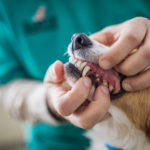Desexing your pet is a vitally important part of being a responsible pet parent. It’s a decision veterinarians encourage all pet parents to make as it will lead to a healthier, happier and potentially longer life.
What is desexing?
Desexing (sometimes referred to as neutering or spaying in females and castrating in males) is a way to prevent unplanned pregnancies, reduce the risk of disease and illness, and reduce any unfavourable behaviours.
What are the benefits for my pet?
| Cats | Dogs |
|
|
The procedure
The desexing procedure varies between females and males.
Female pets:
- Under a general anaesthetic, an incision will be made along the midline or flank. The ovaries and uterus will be carefully removed. Once this is complete, the pet can no longer reproduce or go into heat.
The incision will then be sutured.
Male pets:
- Via a small incision, both testicles are removed under a general anaesthetic. After removal, the site will be sutured. Male desexing is a simpler process, and recovery is much quicker due to the external nature of their reproductive organs.
Our team will provide you with detailed pre and post-surgery information, including recovery time and care.
Before surgery, we may also recommend a blood test to ensure your pet is fit and healthy to proceed.
Recovery
Your pet will need to stay calm for a few days to heal post-surgery. We will ask that you check the incision site daily to check for any swelling, redness, fluids, or anything that looks unusual.
We recommend avoiding strenuous physical activities that can cause stitches to burst or tear. Depending on post-surgery behaviour, your pet may be required to wear a buster collar to prevent touching, scratching, gnawing or licking the site of the incision. These behaviours can cause stitches to be torn or ruptured and can also lead to infection.
We will always provide you with a post-op care plan containing medications such as pain killers and check-ups.
At what age should I desex my pet?
Depending on the breed and sex of your pet, we recommend different timelines.
For example:
- Female dogs should be desexed before their first cycle, where possible.
For most female dogs, this is around six months of age. - Male dog desexing ages can vary greatly based on breed and what is beneficial for their development. A smaller breed may benefit from desexing at six months of age, whereas a large or giant breed may benefit from waiting longer, up to approximately 18 months of age.
- Due to the speed at which cats become sexually mature (some as early as four months old!) it is usually recommended cats of both sexes are desexed by six months of age.
To help control growing cat populations, some councils may charge a regular fee if your cat is not desexed once they are over six months of age. Please check with your local council to confirm any specific fees that may be incurred by owning a non-desexed cat.
All of these recommendations can vary based on your pet’s lifestyle, health, sex and breed. If your pet was not desexed at a younger age, the procedure could usually be carried out at any time during their life.
Speak to your Vet for specific recommendations for your pet.






